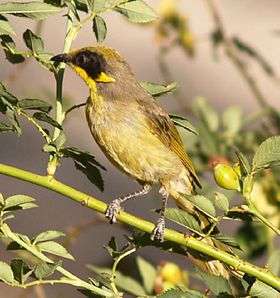Lichenostomus
Lichenostomus is a genus of honeyeaters endemic to Australia.
| Lichenostomus | |
|---|---|
.jpg) | |
| Yellow-tufted honeyeater (Lichenostomus melanops) | |
| Scientific classification | |
| Kingdom: | Animalia |
| Phylum: | Chordata |
| Class: | Aves |
| Order: | Passeriformes |
| Family: | Meliphagidae |
| Genus: | Lichenostomus Cabanis, 1851 |
The genus formerly contained twenty species but it was split after a molecular phylogenetic analysis published in 2011 showed that the genus was polyphyletic.[1] Former members were moved to the six new genera: Nesoptilotis, Bolemoreus, Caligavis, Stomiopera, Gavicalis and Ptilotula.[1]
The genus contains two species:[2]
| Image | Scientific name | Common Name | Distribution |
|---|---|---|---|
_-_Flickr_-_Lip_Kee_(1).jpg) | Lichenostomus melanops | Yellow-tufted honeyeater | east and southeast Australia |
 | Lichenostomus cratitius | Purple-gaped honeyeater | southwest and south-central Australia |
The name Lichenostomus was introduced by the German ornithologist Jean Cabanis in 1851.[3] The word is derived from the Greek leikhēn meaning lichen or callous and stoma meaning mouth.[4]
References
- Nyári, Á.S.; Joseph, L. (2011). "Systematic dismantlement of Lichenostomus improves the basis for understanding relationships within the honeyeaters (Meliphagidae) and historical development of Australo–Papuan bird communities". Emu. 111: 202–211. doi:10.1071/mu10047.
- Gill, Frank; Donsker, David (eds.). "Honeyeaters". World Bird List Version 6.1. International Ornithologists' Union. Retrieved 29 January 2016.
- Cabanis, Jean Louis (1851). Museum Heineannum (Volume 1) (in German). Halbertstadt. p. 119.
- Jobling, James A (2010). The Helm Dictionary of Scientific Bird Names. London: Christopher Helm. p. 226. ISBN 978-1-4081-2501-4.
This article is issued from Wikipedia. The text is licensed under Creative Commons - Attribution - Sharealike. Additional terms may apply for the media files.